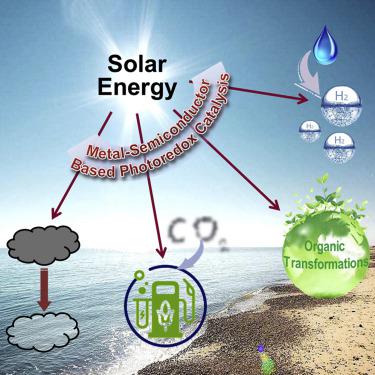Chem ( IF 23.5 ) Pub Date : 2018-05-31 , DOI: 10.1016/j.chempr.2018.05.005 Nan Zhang , Chuang Han , Xianzhi Fu , Yi-Jun Xu

|
Metal-based nanostructures have received great research attention for constructing photoredox catalysts because of their tunable electronic and optical properties, as typically demonstrated by plasmonic metals. In this review, we begin by briefly presenting the development history, basic concept, and influential factors of surface plasmon resonance of metal nanostructures. Then, we describe the mechanisms that have been proposed to explain the metal-plasmon-enhanced photoactivity of semiconductors and their characteristics. Dedicated emphasis is put on the function-oriented engineering strategies for maximizing the efficacy of these mechanisms for improving the performance of metal-semiconductor photocatalysts with theoretical explanations and some representative examples. In addition, we also discuss the latest advances in a non-plasmonic metal that offers a scattered photon-harvesting channel for photoredox catalysis. Finally, we present our vision of the future development in this field. The rational design and deliberate synthesis of metal-semiconductor hybrids in a smart configuration will afford more possibilities toward solar energy conversion.
中文翻译:

面向功能的基于金属的纳米杂化物的光氧化还原催化工程:发挥等离子效应及超越
基于金属的纳米结构由于其可调谐的电子和光学性质而在构造光氧化还原催化剂方面受到了极大的研究关注,如等离激元金属通常所证明的那样。在这篇综述中,我们首先简要介绍金属纳米结构的发展历史,基本概念以及表面等离振子共振的影响因素。然后,我们描述了已经提出来解释半导体的金属等离子体增强光活性及其特性的机理。专门强调功能导向的工程策略,以通过理论解释和一些代表性实例来最大程度地提高这些机制提高金属-半导体光催化剂性能的功效。此外,我们还将讨论非等离子金属的最新进展,该金属为光氧化还原催化提供了一个分散的光子收集通道。最后,我们提出我们对该领域未来发展的愿景。在智能配置中合理设计和精心合成金属-半导体混合材料将为太阳能转换提供更多可能性。



























 京公网安备 11010802027423号
京公网安备 11010802027423号